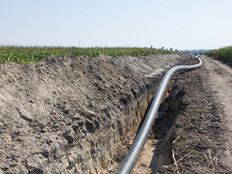FCC Aims to Boost Broadband Deployment
State government IT leaders seeking better broadband service for their constituents should pay heed to the lesson of the Stone Soup folk tale. That’s the message of Jonathan Chambers, chief of the Office for Strategic Policy and Analysis for the Federal Communications Commission.
Delivering a keynote address at the National Association of State Technology Directors Annual Conference in Coeur d’Alene, Idaho, Chambers recounted the story of some soldiers coming across villagers who were unwilling to feed them. The soldiers asked to borrow a pot to make stone soup and drew the curiosity of villagers. The stone soup was coming along, but could’ve been tastier with the addition of a spice or two. So, villagers gave what they could as the soup simmered, contributing salt, carrots, barley and so forth until eventually they had a bountiful meal.
In his previous entrepreneurial endeavors, Chambers viewed the startup phase of a business as the “stone soup phase,” in which companies made something from nothing. But in reading the story to his kids, he saw something different: a tale about community and the spirit of cooperation to create something larger together.
Google Fiber was just that sort of idea. “You’ve got a large company that could afford to put fiber in anywhere, but they wanted engagement from the communities,” explained Chambers. “They went about it in a clever way to get people to apply, and people were excited.” The move fired the imagination of people and spurred several carriers to introduce one gigabit service.
Chambers had his own stone soup idea several months ago when he wanted to transform the way the FCC spends money on programs, such as the Universal Service Fund, E-rate funding to schools and libraries and Telecommunications Relay service to those who have hearing or speech disabilities.
The FCC's Rural Broadband Experiment
In order to engage those beyond the traditional recipients of Universal Service Funds in rural areas, the FCC conducted a rural broadband experiment by asking for ideas about how companies could deploy high-speed Internet services. They received more than 1,000 submissions, called expressions of interest.
“Lack of broadband is a constraint to growth in rural areas,” Chambers said. “The majority of the folks who want to build Fiber to the Home should be given the opportunity.”
The FCC plans to invest $100 million to test different proposals to serve areas with at least 100 megabits per second of bandwidth. The agency will take bids beginning in October.
Such initiatives will require collaboration, so Chambers suggested joining forces with state and local broadband efforts. “We’re spending money and states are spending money to do the same thing,” he said. For example, government could piggyback on existing fiber to schools and libraries and study the maps to see where fiber is lacking.
“I’ve seen the economics, and I think we can get there,” Chambers said. “It takes smart spending, doing it efficiently and taking advantage of those who already have infrastructure out there.”









